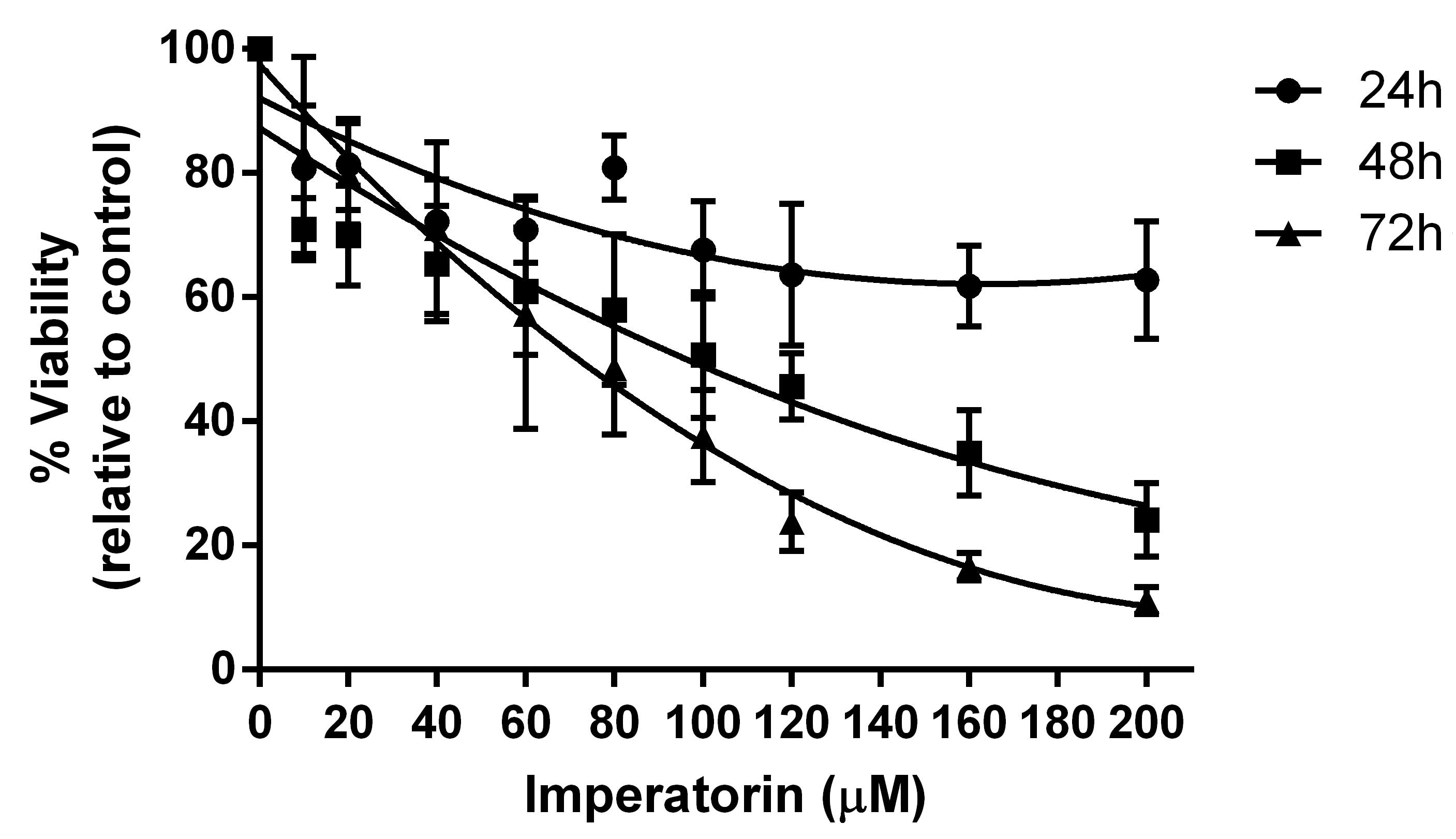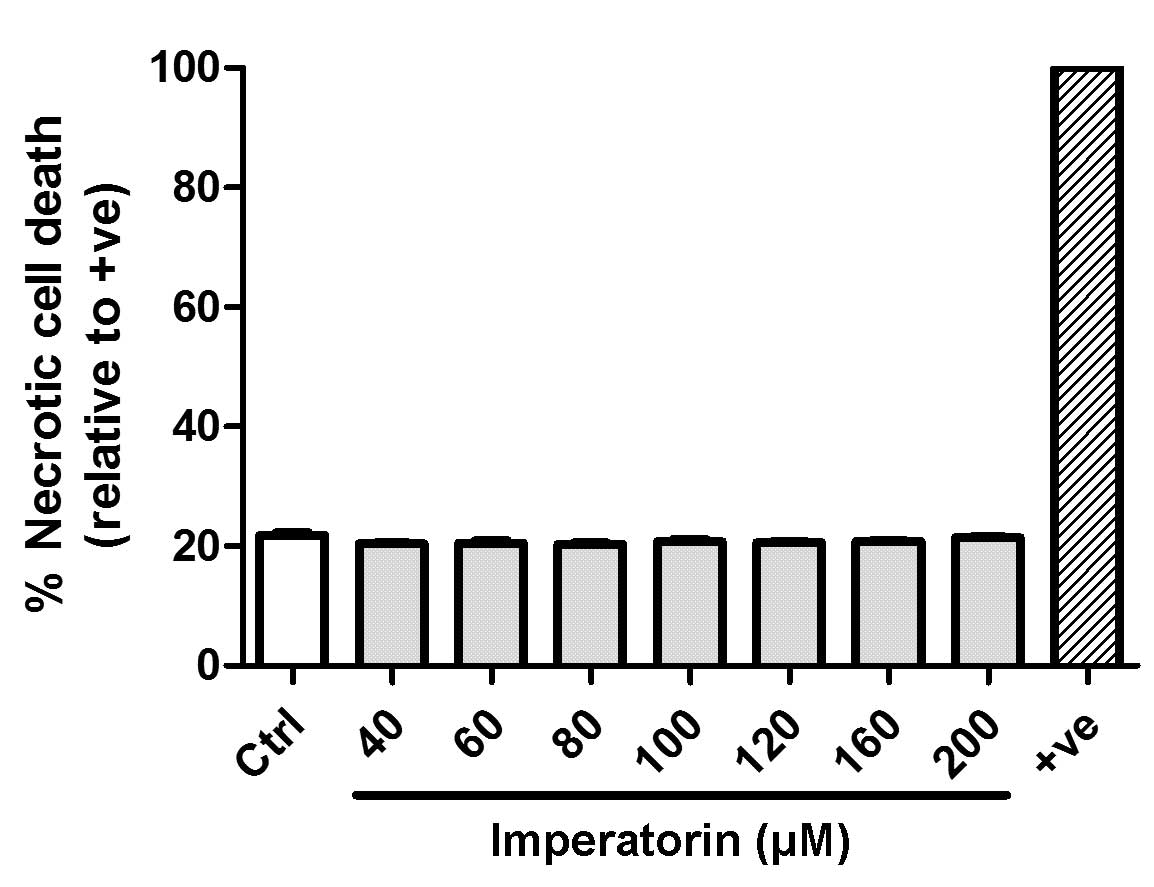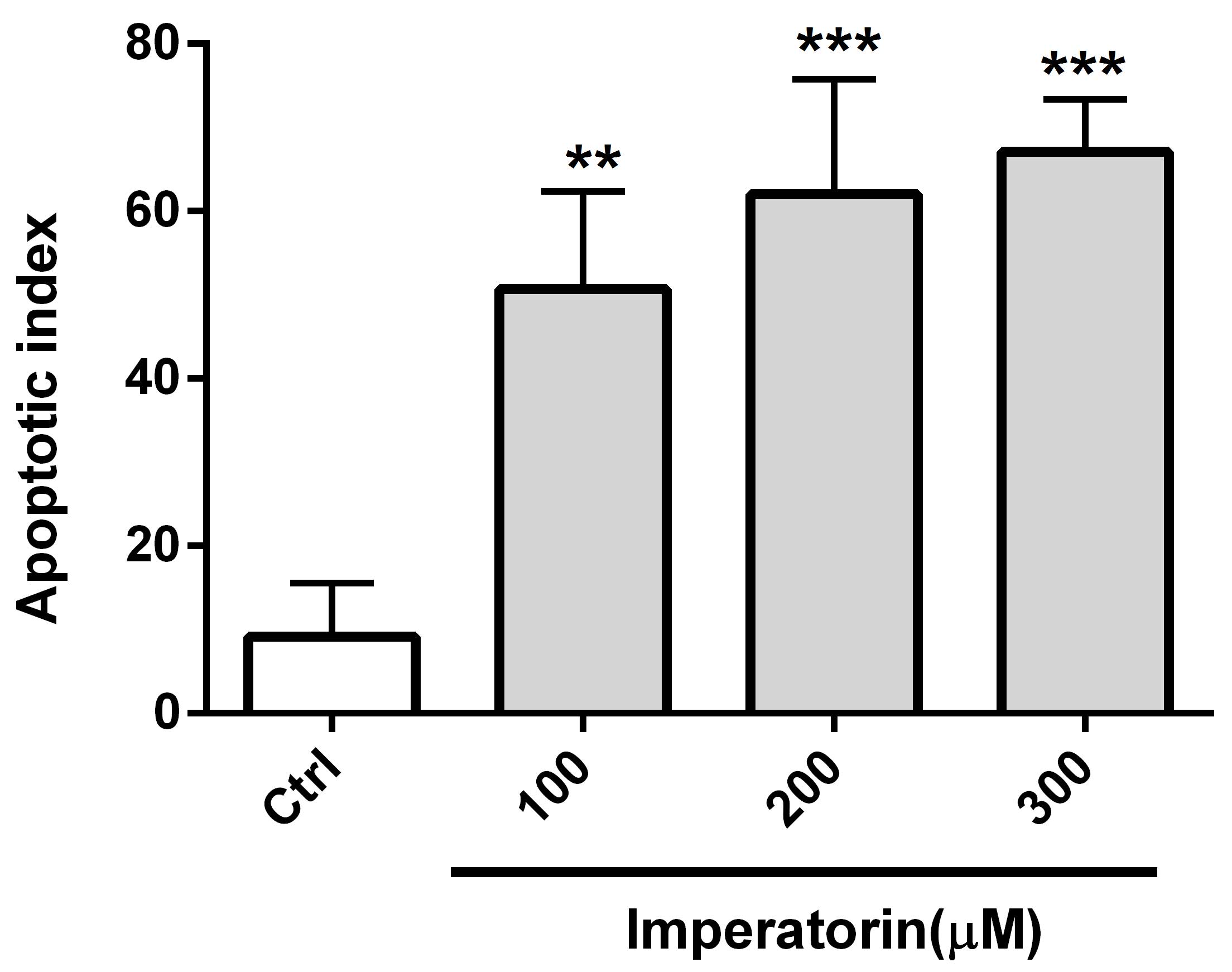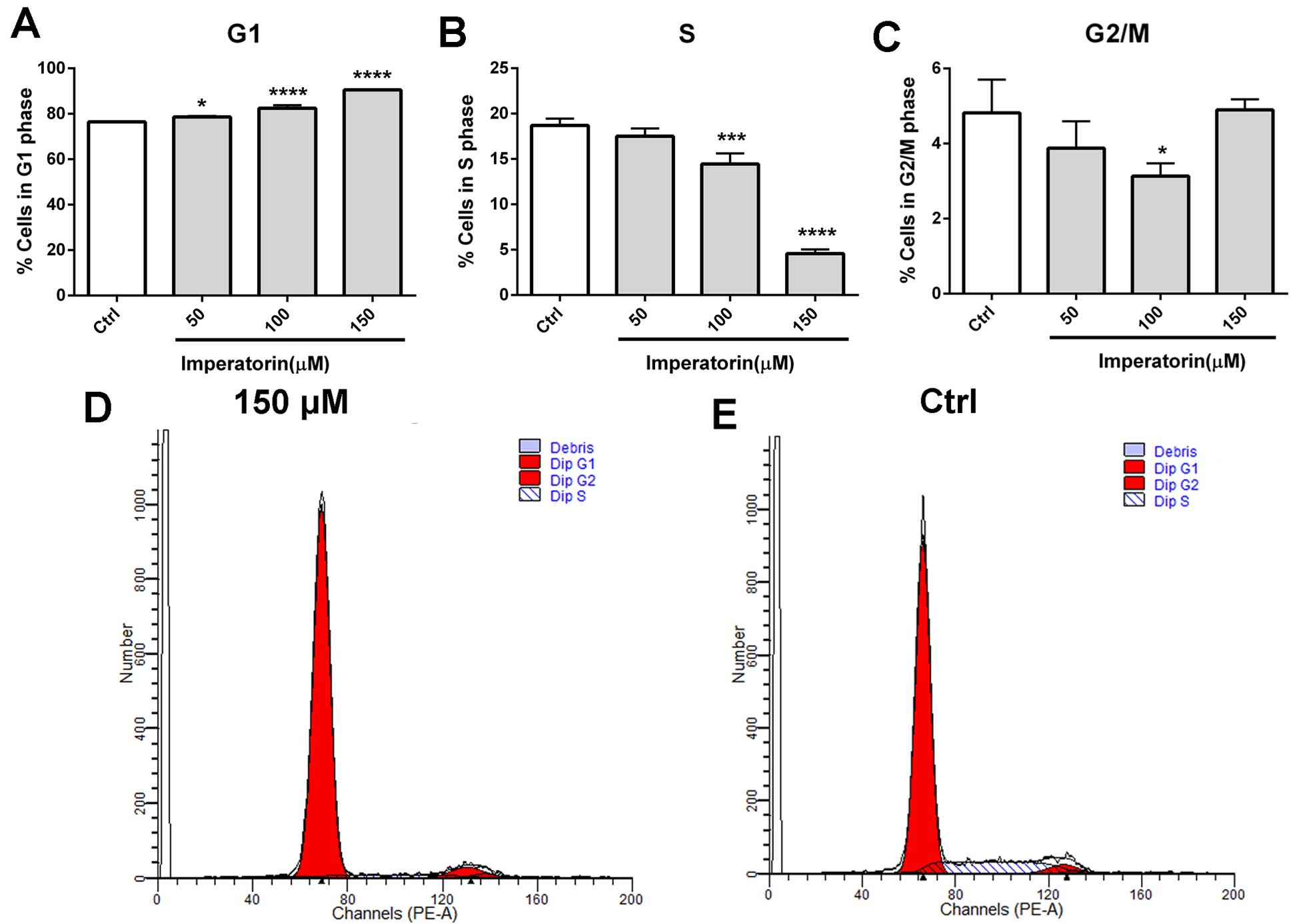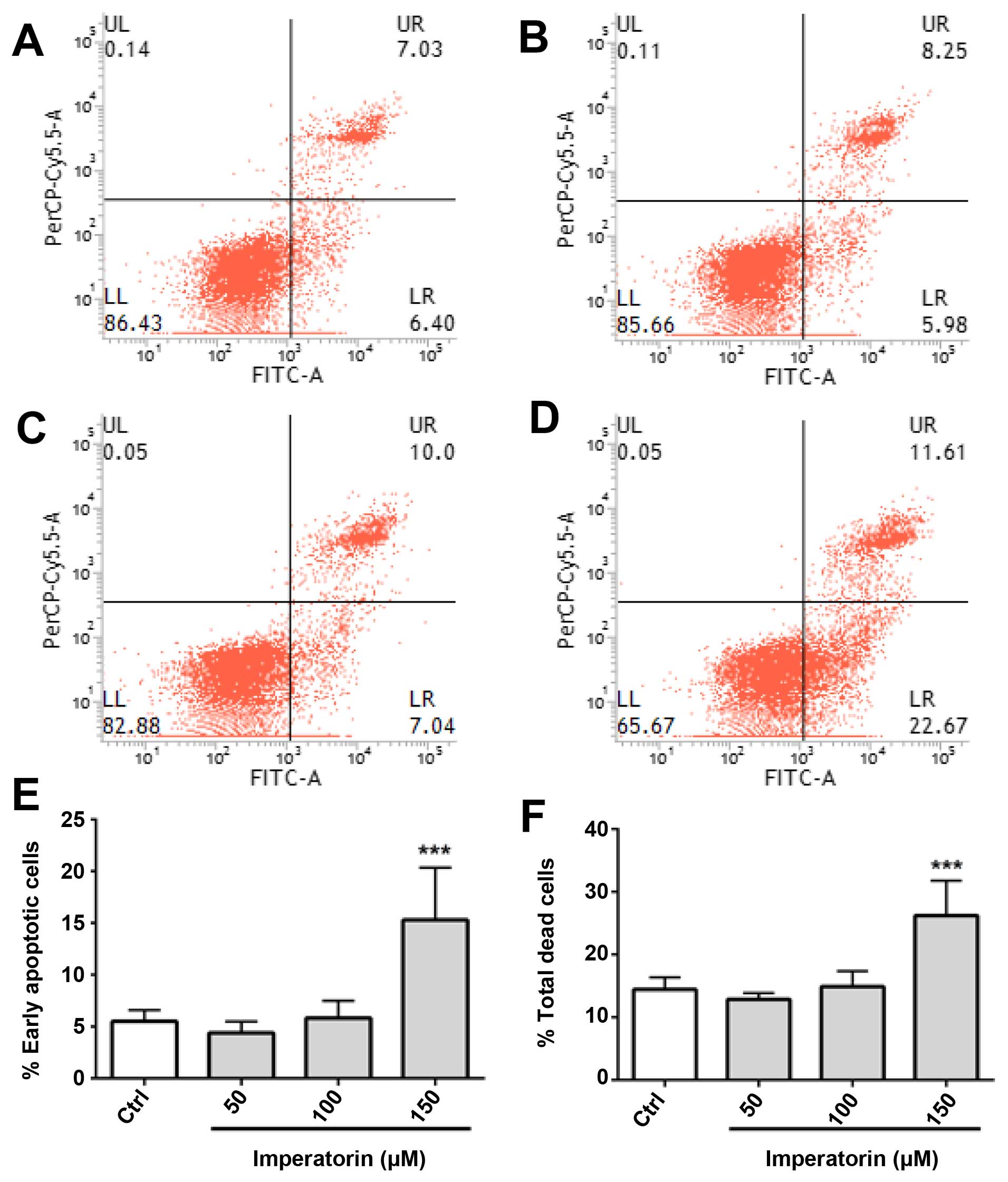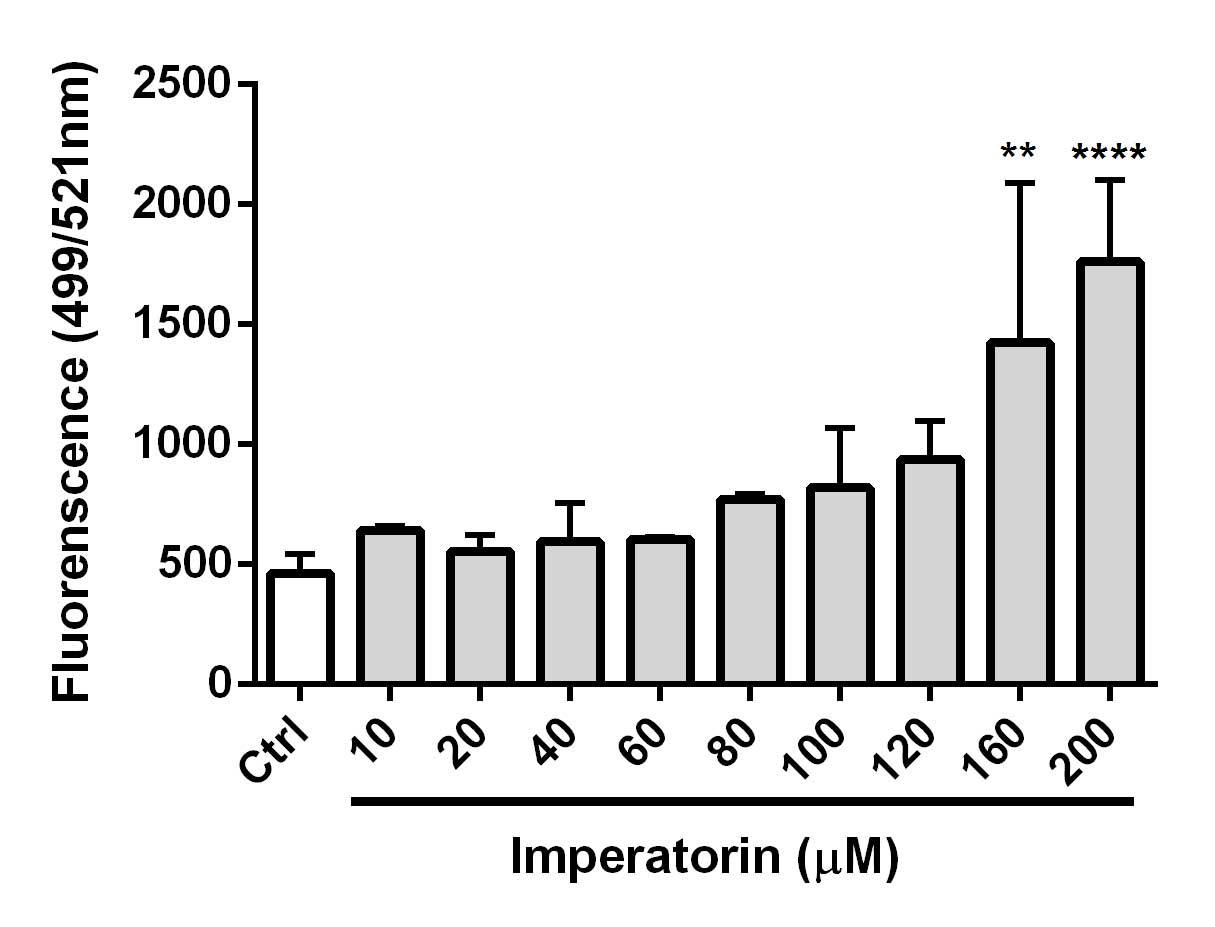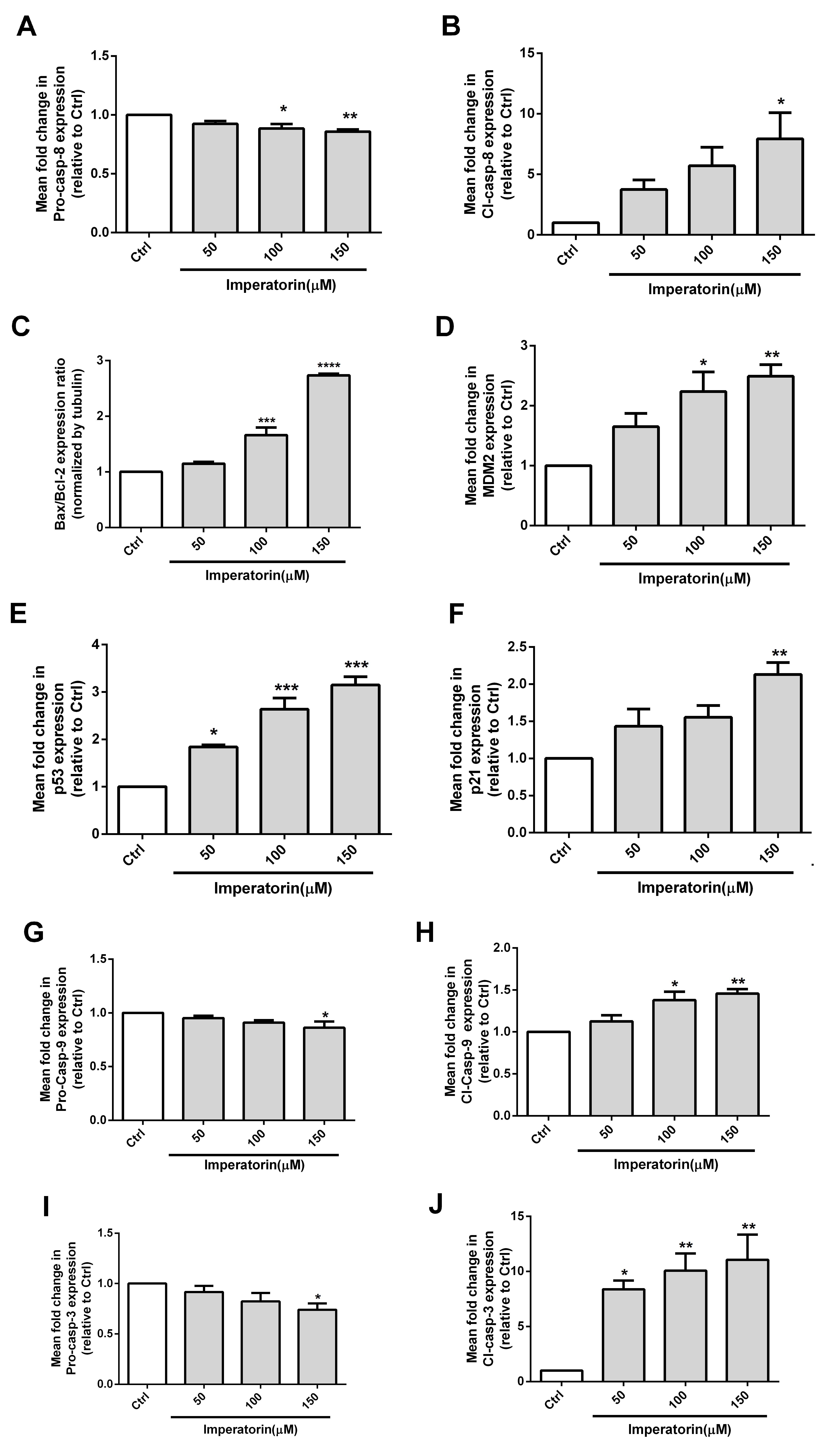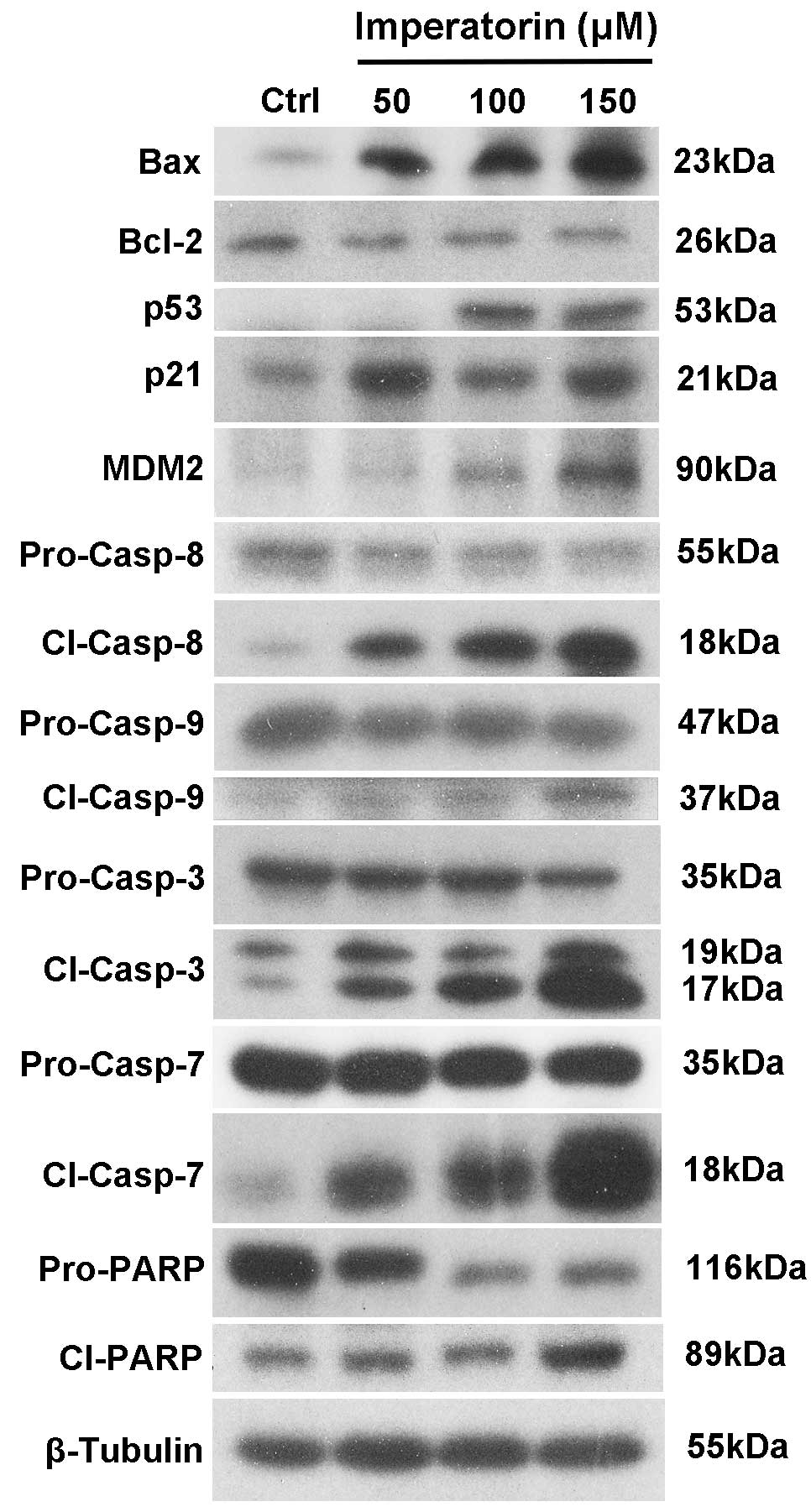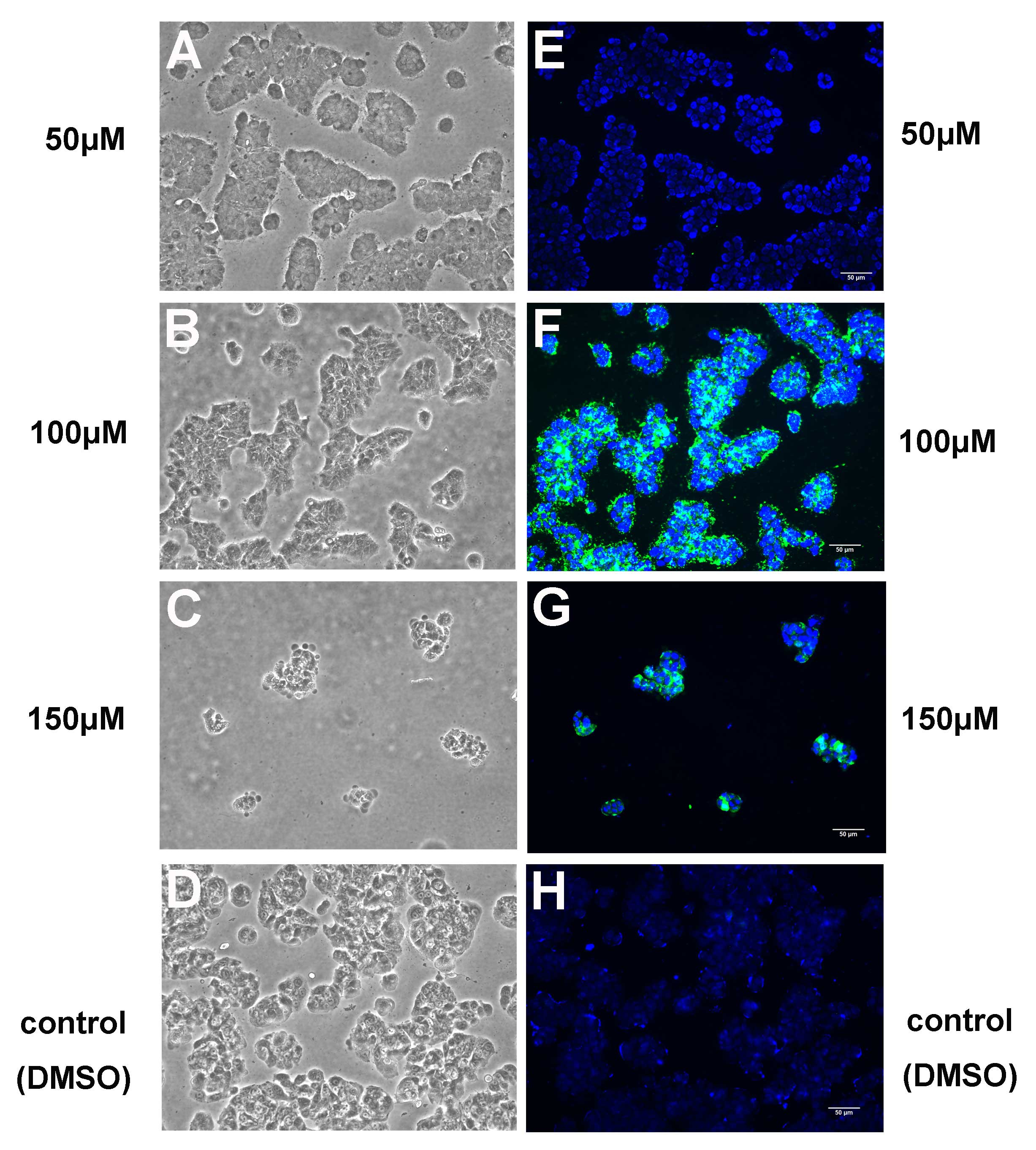Introduction
Colon cancer is one of the leading causes of
cancer-related mortality. Colorectal cancer requires time to
develop. Prognosis and removal of early-stage polyps can prevent
the development of cancer. Early colorectal cancer exhibits no
symptoms. Moreover, a cure is not possible for most patients with
metastatic colorectal cancer. Chemotherapy is the most common
treatment option, which can alleviate symptoms and prolong patient
life. Yet, alternative medicines are required.
Oxidative stress can be caused by the accumulation
of intracellular reactive oxygen species (ROS) through metabolism
of toxic substances. Cancer cells demand high ROS concentrations to
maintain their high proliferation rate due to a higher metabolic
rate. However, ROS levels can be used as a checkpoint with which to
monitor cell damage. The implications for ROS regulation are highly
significant for cancer therapy as commonly used radiotherapy and
chemotherapeutic drugs influence tumor proliferation through ROS
modulation. Anticancer phytochemicals are being used to modulate
the ROS level in cancer cells which is the principal mechanism by
which most anticancer agents function to elicit inhibition of tumor
proliferation. Imperatorin is one of the major active coumarins
found in the root of Imperata cylindrica Beauv. with less
than 4% in the herbal extract (1).
It was reported that imperatorin exhibits many pharmacological
activities including anti-inflammatory, anti-coagulant and
anti-proliferative (1–3). Previous studies showed that
imperatorin inhibited SNU 449 liver cancer cell growth (1). Other studies have shown that
imperatorin mediates oncogene expression and induces cell cycle
arrest (4–8). A recent study showed that imperatorin
suppressed voltage-gate sodium channels and neuronal excitability
through inhibition of the voltage-gate sodium channels (9). In the present study, we investigated
the anti-proliferative activities of imperatorin in HT-29 cancer
cells and its effects on signaling pathways involved in apoptosis
as well as its antioxidant effects. We investigated the expression
of marker proteins involved in these processes and the potential of
imperatorin as an anticancer agent.
Materials and methods
Cells, chemicals and reagents
The HT-29 colon cancer cell line was obtained from
the American Type Culture Collection (ATCC, Manassas, VA, USA).
Acetonitrile (ACN) (E. Merck, Darmstadt Germany), methanol (RCI,
Labscan, Thailand) and trifluoroacetic acid (Sigma-Aldrich, St.
Louis, MO, USA) were of HPLC grade. Distilled and deionized water
(ddH2O) was prepared using the Millipore water
purification system (Millipore, Milford, MA, USA). All other
reagents used were of analytical reagent grade purchased from
Sigma-Aldrich unless stated otherwise. All antibodies were
purchased from Cell Signaling Technology, Inc. (Danvers, MA, USA)
except anti-caspase-8, -Bax, -p21 and -MDM2 which were obtained
from Santa Cruz (Dallas, TX, USA). Imperatorin was purchased from
Sigma-Aldrich.
MTT assay
The growth inhibitory effect of imperatorin was
evaluated in colon cancer HT-29 cells. All cells were seeded onto
96-well microtiter plates, at a density of 6×103 cells
per well and allowed to incubate overnight. The cells were treated
with either 0.5% DMSO [as solvent control (Ctrl)] or various
concentrations of imperatorin (as treatment group) and incubated
for 24, 48 and 72 h at 37°C, respectively. After incubation, MTT
solution (50 µl) was added to each well, and the plates were
incubated at 37°C for 3 h. Then the solution in each well was
replaced by DMSO (150 µl). The absorbance was measured at
540 nm by TECAN Infinite M200 (Tecan Group Ltd., Männedorf,
Switzerland). Each treatment or control was performed in replicates
of 4–6 times. Mean absorbance readings from solvent control groups
were defined as having 100% viability, and the results from the
treatment groups were shown as the percentage of viability relative
to the controls.
Lactate dehydrogenase (LDH) activity
assay
Cells that undergo necrosis are lysed to release
cytosolic LDH into culture medium. The CytoTox 96 Non-Radioactive
Cytotoxicity Assay kit (Promega, Madison, WI, USA) was used to
evaluate the cytotoxic effect of imperatorin on HT-29 cells by
assessing the activity of LDH present in the culture medium. After
a 48-h treatment of the HT-29 cells with imperatorin, the culture
medium was transferred to a 96-well plate, followed by addition of
an equal volume of CytoTox 96 reagent in each well. The plate was
maintained in the dark at room temperature for 30 min. The
enzymatic reaction was stopped by adding an equal volume of stop
solution in each well. The absorbance was measured at 490 nm by
TECAN infinite M200. Maximum LDH activity was achieved by addition
of lysis buffer and normalized by a corresponding volume correction
control. Background values (medium only) were subtracted from the
sample readings, and the percentage of necrotic cell death was
calculated in relation to the maximum LDH release.
TUNEL-based detection of DNA
fragmentation
ApoDIRECT In Situ DNA Fragmentation Assay kit
was used to detect DNA fragmentation in apoptotic cells though
terminal deoxynucleotidyl transferase-mediated dUTP nick end
labeling (TUNEL) method. In brief, HT-29 cells were seeded onto a
6-well plate, at a density of 2×106 cells per well and
allowed to incubate overnight. Then the cells were treated with
various concentrations of imperatorin for 48 h. After a 48-h
treatment, the cells were harvested and fixed with 1% (w/v)
paraformaldehyde (PFA) in physiological buffer (PBS). The cells
were washed with PBS twice and permeabilized with ice-cold 70%
ethanol in PBS for ≥30 min. After fixation, the cells were
centrifuged at 500 × g for 5 min and the supernatant was decanted.
Cell pellets were re-suspended in wash buffer and washed twice
prior to a 1-h incubation in staining buffer. After incubation, the
stained cells were rinsed twice by adding rinsing buffer, followed
by a 30-min incubation in propidium iodide (PI)/RNase A solution in
the dark at room temperature. The amount of fluorescein-labeled
samples was observed using the FACSVerse system (BD Biosciences,
San Jose, CA, USA). The samples presenting a
FITC+/PI− signal were considered as having
fragmented DNA.
Flow cytometric analysis of the cell
cycle
HT-29 cells were seeded onto a 6-well plate, at a
density of 1×106 cells per well and allowed to incubate
overnight. The cells were treated with imperatorin for 48 h. After
a 48-h treatment, the cells were washed with PBS once and harvested
with trypsin. The harvested cells were washed with cold PBS twice
and fixed with 70% ethanol for ≥1 h. The cells were centrifuged at
500 × g for 5 min and washed twice with cold PBS, followed by
addition of PI (final concentration, 40 µg/ml). The cells
were incubated in the dark at 37°C for 15 min.
Fluorescence-activated cells in each sample were recorded with
10,000 events using the FACSVerse system (BD Biosciences). The cell
cycle distribution was analyzed with ModFit (10).
Flow cytometric analysis of
apoptosis
HT-29 cells were cultured and treated with
imperatorin using the same procedures for the cell cycle analysis.
The cells were harvested with trypsin and washed twice with cold
PBS. Then the cells were re-suspended in 1X binding buffer at a
density of 1×106 cells/ml. One hundred microliters of
cell suspension per sample was transferred to a 5-ml culture tube
and stained with 5 µl of FITC Annexin V and 5 µl of
PI (FITC Annexin V Apoptosis Detection kit I; BD Pharmingen,
Franklin Lakes, NJ, USA). The cells were gently vortexed and
incubated for 15 min at room temperature. After incubation, 400
µl of 1X binding buffer was added to each tube.
Fluorescence-activated cells in each sample were recorded with
10,000 events by using the FACSVerse System. The cells presenting a
FITC+/PI− signal were considered as early
apoptotic cells while the cells presenting with a
FITC+/PI+ signal were considered as late
apoptotic or dead cells.
Caspase-3/7 assay
The Apo-ONE Homogeneous Caspase-3/7 Assay kit was
used to evaluate the activities of apoptosis by assessing the
caspase-3/7 enzymatic activities in the imperatorin-treated HT-29
cells. HT-29 cells were seeded onto a 96-well black plate (with
clear bottom), at a density of 6×103 cells per well and
allowed to incubate overnight. Then the cells were treated by
either 0.5% DMSO [as negative control group (Ctrl)] or various
concentrations of imperatorin and incubated for 48 h. After
incubation, an equal volume of Apo-ONE caspase-3/7 reagent was
added to each well. The plate was incubated for 3 h at room
temperature prior to recording the rate of fluorescence (RFU) of
each well at excitation 485 nm and emission 530 nm using a TECAN
infinite M200.
Western blot analysis
Western blot analysis was carried out following the
recommended protocol from Abcam (Cambridge, UK). In brief, HT-29
cells were seeded onto 100-mm culture dishes, at a density of
2×106 cells per dish and incubated for 24 h prior to a
48-h treatment with various concentrations of imperatorin. After a
48-h treatment, the cells were harvested and lysed using
Nonidet-P40 lysis buffer [150 mM sodium chloride, 1% Triton X-100,
50 mM Tris, pH 8.0, supplemented with protease inhibitor cocktails
(Roche)]. The protein concentration was determined using the DC
protein assay (Bio-Rad, Hercules, CA, USA) according to the
manufacturer's protocols using bovine serum albumin (BSA) as the
standard. Normalized protein samples were denatured in a boiling
water bath for 10 min and subjected to sodium dodecyl sulfate
polyacrylamide gel electrophoresis (SDS-PAGE) to separate the
proteins using 80–120 V for 2 h. Proteins were transferred from the
gel to a 0.25-µm PVDF membrane at 12 V for 30 min using the
Novex Semi-dry blotter (Invitrogen Life Technologies, Carlsbad, CA,
USA). Then the membrane was blocked with non-fat dry milk (5% w/v)
in TBST for 1 h at room temperature before incubation with the
specific primary antibody (at appropriate dilution suggested by the
product data sheet) in 4 ml of 5% non-fat milk at 4°C overnight.
After washing with TBST, the membrane was incubated with the
species appropriate HRP-conjugated secondary antibody (at 1:2,000
dilution) in 4 ml of 5% non-fat milk at room temperature for 1 h.
Signals were developed using ECL chemiluminescence detection
reagent (GE, Fairfield, CT, USA) and blots were visualized after
exposure to Fuji Super RX film. The membrane was re-probed with
β-tubulin as an internal control. The intensity of the blots was
quantified by ImageJ image processing program.
ROS assay
Image-iT LIVE Green Reactive Oxygen Species
Detection kit is used to detect the production of ROS in live
cells. In brief, HT-29 cells (1×106 per well) were
seeded on a 6-well plate and allowed to incubate overnight. Then
the cells were treated with various concentrations of imperatorin
and incubated for 24 h. After a 24-h treatment, the cells were
washed with warm Hank's balanced salt solution (HBSS) once before a
25-min incubation with 25 µM carboxy-H2DCFDA and
an additional 5-min incubation with 5 µM Hoechst 33342. The
coverslips were gently washed three times with warm HBSS and
mounted for fluorescent imaging at excitation 485 nm and emission
530 nm by Nikon E80i (Nikon, Tokyo, Japan).
Data analysis
In all viability assays, the viable cells were
measured as a percentage relative to the solvent control groups and
expressed as means ± SD (n≥3). Nonlinear regression test was
applied to the viability assays to obtain a fit curve
(R2>0.98). Statistical analysis of data was carried
out by one-way ANOVA (coupled with post-test, Dunnett's test) to
test for differences between the control group and treatment
groups. Values of P<0.05, P<0.01, P<0.005 and P<0.001
were considered to indicate statistically significant differences
and are indicated by asterisks in the figures.
Results and Discussion
In the present study, different concentrations of
imperatorin were used to treat HT-29 cells. An in vitro
study on HT-29 colon cancer cells revealed that imperatorin
inhibited cell viability with an IC50 value of 239
µM after 24 h, 101 µM after 48 h and 78 µM
after 72 h of incubation (Fig. 1).
The percentage of necrotic cell death remained unaffected with an
increase in imperatorin concentration (Fig. 2). The results suggest that
imperatorin did not cause necrosis of HT-29 cells. In contrast, the
apoptotic index which is used to determine cancer cell growth and
is inversely related to necrosis showed a concentration-dependent
increase in the HT-29 cells (Fig.
3). The results indicate that imperatorin induced programmed
cell death and provide supportive evidence for an
imperatorin-induced apoptotic mechanism that could be mediated
through different apoptotic activities (11). The duration of the apoptotic
activity was largely dependent on the concentration of the
anti-proliferative agent. The common technique that is adopted for
measuring the apoptotic index is flow cytometry. Cell cycle
analysis showed that imperatorin induced cell cycle arrest at the
G1 phase (Figs. 4 and 5). Apoptotic cell death can result from
activation of interrelated molecular cascades. The extrinsic
pathway transduces extracellular stimulus through the plasmatic
membrane. In contrast, the intrinsic pathway modulates the
intracellular environment that controls the survival or death of
cells. Mitochondria play an important role in controlling the
signaling pathways leading to death or survival of cells; thus,
anti-proliferative agents can induce oxidative stress and
alterations in the mitochondrial membrane that leads to apoptosis
activation. These two pathways translate into a convergent point
where caspases downregulate the apoptotic activities. The intrinsic
apoptotic pathway involves the mitochondria and activation of the
caspase cascade which was triggered by imperatorin (Fig. 6). The caspase-3/7 activities in the
HT-29 cells after treatment with imperatorin showed a considerable
increase. Stimulation of the intrinsic apoptotic pathway by
imperatorin triggered a signaling cascade that resulted in the
increase of the apoptotic process with caspase-3/7, which were
activated with the increasing concentration of imperatorin. These
data demonstrate the anti-proliferative activity of imperatorin in
HT-29 cells. The fluorescence values for caspase-3/7 provided a
sensitive approach to analyze the apoptotic and anti-proliferative
effect of imperatorin treatment. The results showed that
imperatorin activated caspases resulting in enhancing caspase
activity (Fig. 6). The activation
of this intrinsic pathway was accompanied by Cyt-C and the caspase
cascade (Fig. 8).
The Bcl-2 family members exhibit a regulatory role
in determining cell viability. These members exert checkpoints to
modulate apoptotic activities. The ratio between pro-apoptotic
factors including Bax, Bad, Bak, Bid, MDM2 and anti-apoptotic
members is a useful marker for measuring apoptosis. Changes in
expression of Bcl-2 is indicative of the alteration of
mitochondrial membrane potential. Fig.
7 shows that imperatorin modulated the alteration of the
expression of these key apoptotic members in the HT-29 cells. Other
key molecules involved in apoptosis regulation is alteration of the
transcription factor p53 (Fig. 8).
The main role of p53 is to mediate tumorigenesis (12). Cancer involves complex cellular
changes which are associated with uncontrollable replication and
resistance to growth-controlled mechanisms.
Malignant tumors may metastasize through the
circulatory system. Consequently, metastasis causes significant
tumor burden. At present, strategies of cancer treatment using
phytochemicals in combination with targeted therapies are
considered promising, and may lead to greater efficacy and enhanced
patient survival rates (13).
Malignant cells may find alternative survival mechanisms. Indeed,
imperatorin is capable of modulating cell conditions that may cause
alteration in expression profile of oncogenes and cell cycle
mechanisms of cancer cells. Anti-proliferative agents can
consequently be used to suppress cancer cell survival or death
based on the modulation of the intrinsic pathway. Imperatorin was
shown to modulate the intrinsic pathway involving Bcl-2 members,
p53, p21, MDM2 and the caspase cascade (Fig. 8), and triggered considerable changes
in Bax, caspase-8, MDM2, p53 and p21 expression (Fig. 8).
The maintenance of homeostasis is known to be
important in normal tissues that require a balance between cell
proliferation and cell death. Bcl-2 family members play a
significant role in the regulation of cell death. Bcl-2 is involved
in programmed cell death. Overexpression of Bcl-2 in cells results
in extended cell survival. Bcl-2 does not appear to affect the
generation of reactive oxygen radicals but may prevent oxidative
damage to cellular constituents. A pre-set ratio of Bcl-2/Bax
appears to determine the cell survival or death of cells after an
apoptotic stimulus (14). The
increase in Bax/Bcl-2 expression following incubation of the HT-29
cells with imperatorin suggests induction of apoptosis of HT-29
cancer cells. The overexpression of p53 and p21 provided supportive
evidence of apoptosis (Fig. 8).
The anti-proliferative activity of imperatorin was
demonstrated in the present study. The alteration of gene
expression in imperatorin-treated HT-29 cells revealed that
imperatorin induced apoptosis via a p53-dependent pathway. The
results are analogous with in vitro studies in HepG2 cells
(1). The production of reactive
oxygen species (ROS) in HT-29 after treatment with imperatorin was
examined using an ROS detection kit. Imperatorin increased the ROS
levels in the HT-29 cells but not in normal cells (3). However, there is little information
concerning the selectivity of imperatorin. The cellular changes
were examined under bright-field microscope and fluorescence
microscope (Fig. 9). The results
showed that the level of ROS was increased with increasing
concentrations of imperatorin. One of the advantages of staining
methodology is the ability to show the qualitative analysis with
both phase contrast and fluorescent images. The classical
morphological changes associated with apoptosis include cell
shrinkage, membrane blebbing, nuclear condensation, and DNA
fragmentation. The microscopic examination of the cellular changes
presented in Fig. 8 highlights this
advantage, illustrating the ability to use phase contrast and
fluorescent blended images to correlate the activation of
caspase-3/7 and the disintegration of nuclei due to cell death that
showed morphological changes in response to treatment with
imperatorin. The results significantly enhance the confidence in
the measured apoptotic activities and conclusions drawn from the
image analysis. The resulting data revealed the effectiveness of
imperatorin as an anti-proliferative agent.
In conclusion, the results demonstrated the
anti-proliferative activities of imperatorin in the HT-29 cell
line. Imperatorin induced apoptosis via the activation of
caspase-3/7, a primary and irreversible executioner pathway in
HT-29 cancer cells. The fluorescent labeling assay demonstrated the
inhibitory effects of imperatorin on HT-29 cell proliferation. The
results provide confirmative evidence of apoptotic signaling in
HT-29 cells. The results were validated by individual images.
Together, these results provide experimental evidence for apoptotic
signaling after treatment of HT-29 cells with imperatorin. The
anti-proliferative activities of imperatorin in HT-29 cells were
demonstrated in the present study.
Acknowledgments
Professor Yi Mei Zheng gratefully acknowledged the
support by the Training Program of FuJian Excellent Talents in
University in China. The present study was supported in part by a
grant no. 6903088 from CUHK.
References
|
1
|
Rahman A, Siddiqui SA, Jakhar R and Kang
SC: Growth inhibition of various human cancer cell lines by
imperatorin and limonin from Poncirus trifoliata Rafin. seeds.
Anticancer Agents Med Chem. 15:236–241. 2015. View Article : Google Scholar
|
|
2
|
Kumar D, Bhat ZA, Kumar V and Shah MY:
Coumarins from Angelica archangelica Linn. and their effects on
anxiety-like behavior. Prog Neuropsychopharmacol Biol Psychiatry.
40:180–186. 2013. View Article : Google Scholar
|
|
3
|
Sigurdsson S and Gudbjarnason S: Effect of
oral imperatorin on memory in mice. Biochem Biophys Res Commun.
441:318–320. 2013. View Article : Google Scholar : PubMed/NCBI
|
|
4
|
Sigurdsson S, Ogmundsdottir HM and
Gudbjarnason S: Antiproliferative effect of Angelica archangelica
fruits. Z Naturforsch C. 59:523–527. 2004. View Article : Google Scholar
|
|
5
|
Luszczki JJ, Glowniak K and Czuczwar SJ:
Imperatorin enhances the protective activity of conventional
antiepileptic drugs against maximal electroshock-induced seizures
in mice. Eur J Pharmacol. 574:133–139. 2007. View Article : Google Scholar : PubMed/NCBI
|
|
6
|
Sancho R, Márquez N, Gómez-Gonzalo M,
Calzado MA, Bettoni G, Coiras MT, Alcamí J, López-Cabrera M,
Appendino G and Muñoz E: Imperatorin inhibits HIV-1 replication
through an Sp1-dependent pathway. J Biol Chem. 279:37349–37359.
2004. View Article : Google Scholar : PubMed/NCBI
|
|
7
|
Appendino G, Bianchi F, Bader A,
Campagnuolo C, Fattorusso E, Taglialatela-Scafati O, Blanco-Molina
M, Macho A, Fiebich BL, Bremner P, et al: Coumarins from Opopanax
chironium. New dihydrofuranocoumarins and differential induction of
apoptosis by imperatorin and heraclenin. J Nat Prod. 67:532–536.
2004. View Article : Google Scholar : PubMed/NCBI
|
|
8
|
Kim YK, Kim YS and Ryu SY:
Antiproliferative effect of furanocoumarins from the root of
Angelica dahurica on cultured human tumor cell lines. Phytother
Res. 21:288–290. 2007. View
Article : Google Scholar
|
|
9
|
Wu KC, Chen YH, Cheng KS, Kuo YH, Yang CT,
Wong KL, Tu YK, Chan P and Leung YM: Suppression of voltage-gated
Na(+) channels and neuronal excitability by imperatorin. Eur J
Pharmacol. 721:49–55. 2013. View Article : Google Scholar : PubMed/NCBI
|
|
10
|
Allen GD: MODFIT: a pharmacokinetics
computer program. Biopharm Drug Dispos. 11:477–498. 1990.
View Article : Google Scholar : PubMed/NCBI
|
|
11
|
Potten CS: What is an apoptotic index
measuring? A commentary. Br J Cancer. 74:1743–1748. 1996.
View Article : Google Scholar : PubMed/NCBI
|
|
12
|
Lavin MF and Gueven N: The complexity of
p53 stabilization and activation. Cell Death Differ. 13:941–950.
2006. View Article : Google Scholar : PubMed/NCBI
|
|
13
|
Mitsiades CS, Davies FE, Laubach JP,
Joshua D, San Miguel J, Anderson KC and Richardson PG: Future
directions of next-generation novel therapies, combination
approaches, and the development of personalized medicine in
myeloma. J Clin Oncol. 29:1916–1923. 2011. View Article : Google Scholar : PubMed/NCBI
|
|
14
|
Korsmeyer SJ, Shutter JR, Veis DJ, Merry
DE and Oltvai ZN: Bcl-2/Bax: A rheostat that regulates an
anti-oxidant pathway and cell death. Semin Cancer Biol. 4:327–332.
1993.PubMed/NCBI
|















